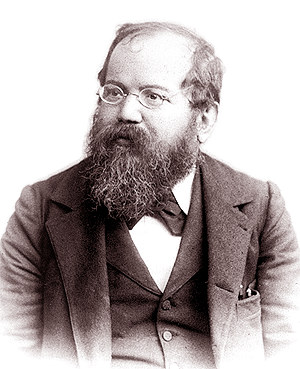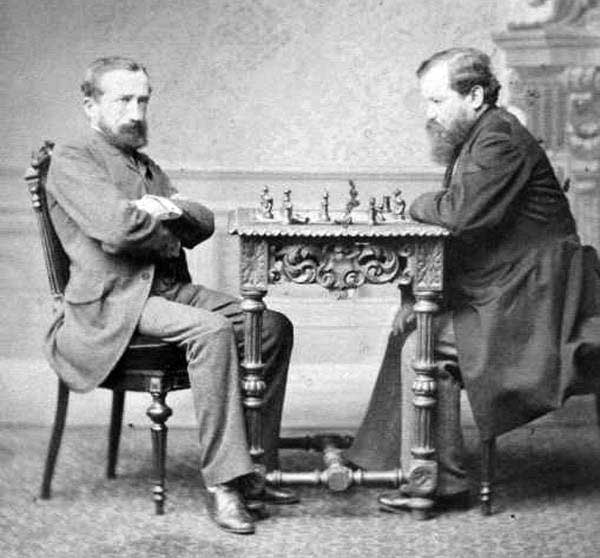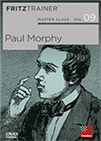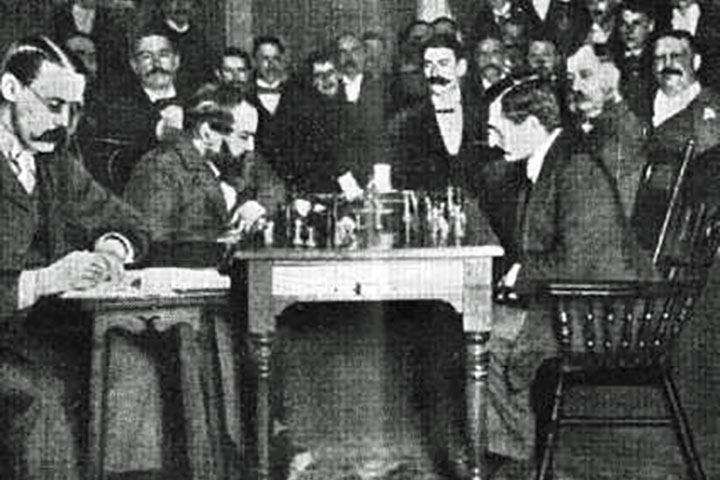First steps
 Steinitz was born on May 17, 1836, in the Jewish ghetto of Prague, the youngest of a tailor's thirteen sons to survive. Though he learned to play chess at age 12, he only began to take it seriously in his twenties, after leaving Prague in 1857 to study mathematics in Vienna, at the Vienna Polytechnic.
Steinitz was born on May 17, 1836, in the Jewish ghetto of Prague, the youngest of a tailor's thirteen sons to survive. Though he learned to play chess at age 12, he only began to take it seriously in his twenties, after leaving Prague in 1857 to study mathematics in Vienna, at the Vienna Polytechnic.
There he progressed swiftly, taking third in the 1859 Vienna City Championship, and two years later came in first in the 1961 Vienna City Championship with the spectacular score of 30.0/31. He was now acknowledged as the strongest player in Austra, and was sent as its representative to the 1862 London Chess Tournament. The winner was the number one player at the time, Adolf Anderssen, while he placed sixth, but he did earn the brilliancy prize with his victory over Augustus Mongredien.
Steinitz vs Mongredien (Annotations by Garry Kasparov)

[Event "British CA-05 Grand Tournament"] [Site "London"] [Date "1862.??.??"] [Round "?"] [White "Steinitz, William"] [Black "Mongredien, Augustus"] [Result "1-0"] [ECO "B01"] [Annotator "Kasparov,G"] [PlyCount "57"] [EventDate "1862.06.13"] [EventType "tourn"] [EventRounds "13"] [EventCountry "ENG"] [SourceTitle "EXT 2000"] [Source "ChessBase"] [SourceDate "1999.11.16"] [SourceVersion "1"] [SourceVersionDate "1999.11.16"] [SourceQuality "1"] 1. e4 d5 2. exd5 Qxd5 3. Nc3 Qd8 4. d4 e6 5. Nf3 Nf6 6. Bd3 Be7 7. O-O O-O 8. Be3 b6 9. Ne5 Bb7 10. f4 Nbd7 11. Qe2 Nd5 $2 12. Nxd5 exd5 13. Rf3 f5 14. Rh3 g6 15. g4 fxg4 (15... Nxe5 $142 {/\ Bc8 Neistadt}) {I have to admit I was truly amazed by the flood of your replies, dear readers! I can vividly imagine how many line you went through, the amount of work you committed, to come up with such outstanding results. Even the great Steinitz would have been surprised to find out how much play was left behind the scenes, play that you have helped to disclose! So let us go through these exciting variations once again: FIRST: The rook sacrifice *is* winning, but it was not the easiest way. Those of you who reached this conclusion should be congratulated.} 16. Rxh7 $1 (16. Qxg4 Nf6 ( 16... Nxe5 17. dxe5 (17. Qe6+ $2 Nf7 $2 {would lead to disaster:} (17... Rf7 $3 {refutes White's brave attempt.} 18. Qxe5 (18. Bxg6 {the only chance} hxg6 (18... Nxg6 19. Rxh7 {is unclear}) 19. fxe5 Bc8 20. Qxg6+ Rg7 {and White's attack runs out of steam}) (18. fxe5 Bc8) 18... Bf6 19. Qe6 Bc8 {etc.}) 18. Bxg6 Bh4 19. Qg4 hxg6 20. Qxg6+ Kh8 21. Kh1 $1 (21. Qh5+ Kg7 22. Rxh4 {doesn't work because of} Bc8 23. Kh1 Bf5 $17) 21... Rg8 22. Qxf7 Rg7 23. Qh5+ Rh7 24. Qe5+ Bf6 (24... Qf6 25. Rxh4 $1) 25. Rxh7+ Kxh7 26. Qf5+ Kg7 (26... Kh8 27. Qh3+ Bh4 28. Rg1 Bc8 29. Qg2 Qf8 30. Qg6 {winning?}) 27. Rg1+ Kf7 28. Qh7+ Ke6 29. f5+ Kd6 30. Rg6 $1 Qe7 31. Rxf6+ Qxf6 32. Bf4+ Kc6 33. Qxc7+ Kb5 34. Qxb7 Qxd4 35. a4+ $1 Ka5 36. Qxa8 {winning.}) (17. fxe5 $2 {proposed by some readers, but refuted by Fritz:} Bc8 $1 18. e6 Rf6 $19) 17... Bc8 18. e6 $16 {-> Neistadt} ) 17. Qg2 Bc8 18. Rxh7 Kxh7 19. Qxg6+ Kh8 20. Kh1 $18) 16... Nxe5 (16... Kxh7 17. Qxg4 Nf6 18. Qxg6+ Kh8 19. Qh6+ Kg8 20. Kh1 $18) (16... Nf6 {some of you tried this but without success:} 17. Rh6 $18 {or oder}) (16... Rf6 17. Qxg4 $1 Kxh7 18. Bxg6+ $18 {crushing}) 17. fxe5 Kxh7 (17... Ba6 {was tricky, but also failed:} 18. Rh6 $1 Bxd3 19. Qxd3) (17... Bg5 $5 { Those who found a hidden counter attacking resource with 16...Bg5 17.Bxg6 Rf3 deserves serious credit. In fact, after 16.Bg5 White has a pleasent alternative.} 18. Bxg5 Qxg5 19. Rxc7 Bc8 (19... g3 {looks dangerous (19.Rxb7? Rf2) but the arrow doesn't reach the target.} 20. hxg3 $1 Qxg3+ 21. Qg2 Qe3+ 22. Kh1 Qh6+ 23. Qh2) 20. Kh1 {with big advantage.}) (17... Rf3 {Anyway, 16...Rf3 could force the above line.} 18. Bxg6 Bg5 {Here} 19. Bxg5 $2 (19. Bf2 $1 { is correct.} Bf4 20. Bh4 Bg5 21. Qg2 $3 Bc8 22. Rf1 $1 {and White is again on top!}) 19... Qxg5 20. Rxc7 Qxg6 21. Rxb7 Raf8 22. Qg2 Qe4 {with idea Qf4 gives Black sufficiant counterplay.}) 18. Qxg4 Rg8 { loses instantly.} (18... Qe8 19. Qh5+ Kg8 (19... Kg7 $1 20. Qh6+ Kg8 21. Bxg6 Rf7 22. Kh1 Bf8 23. Qh5 (23. Bxf7+ {You also paid attention to the line starting with Bxf7. After} Qxf7 24. Rg1+ Bg7 25. Qf6 $1 Re8 26. Bh6 Qxf6 27. exf6 Re1 $1 28. Bxg7 (28. Rxe1 $1 Bxh6 29. Re7 Bf4 30. h4 { Black can't organize coordination of his pair of bishops and the white king comes into the game with decisive effect.}) 28... Rxg1+ 29. Kxg1 { we reach an endgame that I have difficulties to assess correctly. After} Kf7 30. Kf2 Bc8 31. Ke3 Bf5 32. c3 Ke6 {the white bishop has to stay passively on g7 and the king has no way of penetrating Black's camp on the kingside (only very deep analysis can tell us whether there is a path for the white king on the queenside). But 27.Rxe1!... (see above)}) 23... Bg7 (23... Qd7 24. Rg1 Bg7 25. Qh7+ Kf8 26. Bxf7 Qxf7 27. Rxg7 Qf1+ 28. Rg1 Qf3+ 29. Rg2) (23... Qe6 24. Rg1 Bg7 25. Qh7+ {and as above}) 24. Rg1 (24. Qh7+ Kf8 25. Bh6 { gives only perpetual check} Bxh6 26. Qxh6+ Ke7 27. Qg5+ Kf8 $10) 24... Kf8 25. Rg3 $3 {only way} (25. Bxf7 Qxf7 26. Rg6 Qf1+ 27. Rg1 Qf7 {save Black's game}) 25... Rf1+ 26. Kg2 {etc.}) 20. Bxg6 Rf7 21. Kh1 Bf8 22. Rg1 Bg7 23. Bh6 $18) (18... Rf5 19. Bxf5 gxf5 20. Qxf5+ Kg7 (20... Kh8 21. Qh5+ Kg8 22. Kh1 $18) 21. Kh1 { and the black king has to face overwhelming enemy force practically alone.}) 19. Qh5+ Kg7 20. Qh6+ (20. Qxg6+ $4 {of course turns the tables.} Kh8 $1) 20... Kf7 21. Qh7+ Ke6 (21... Rg7 $145 22. Bxg6+ Kf8 23. Qh8+ Rg8 24. Bh6#) 22. Qh3+ Kf7 23. Rf1+ (23. e6+ $1 {forces mate in eight and finishes the king hunt faster.}) 23... Ke8 24. Qe6 Rg7 25. Bg5 (25. Bh6 $18) 25... Qd7 (25... Bc8 26. Qc6+ Bd7 27. Qxg6+ Rxg6 28. Bxg6#) 26. Bxg6+ Rxg6 (26... Kd8 27. Rf8+ Qe8 28. Rxe8#) 27. Qxg6+ Kd8 28. Rf8+ Qe8 29. Qxe8# 1-0
The king of matches
Right after the tournament, he challenged Serafino Dubois, an Italian master who placed fifth, which Steinitz won 5½ : 3½. This started the greatest winning streak of matches in history, as rising star was to win every official match he played for the next 32 years, from 1862 until he relinquished his title in 1894 to Emanuel Lasker.
His claim to being the world’s best player would only come four years later when, in 1866, he played Adolf Anderssen in a match. Anderssen was widely considered the best active player (Morphy had already retired from play), having won both the 1851 and 1862 London International Tournaments. The stakes were enormous, with a prize money of 100 Pounds going to the winner, equivalent to $15 thousand today. It was a hard-fought match and after 12 games, the score was all tied up 6 : 6. Steinitz dug deep and won the last two games to finish with eight wins, six losses and no draws. As a result of this match victory, Steinitz inherited the mantle of world’s best player.
Father of chess strategy
Steinitz’s successes until 1872 had been with the attack-at-all-costs style that ruled the day, exemplified by Anderssen himself. However in 1873, at the Vienna International tournament, Steinitz unveiled his new concept of the “positional” style of play, which was to become the basis for modern chess.
Steinitz's play suddenly changed, giving priority to what is now called the positional elements in chess: pawn structure, space, outposts for knights, the advantage of the two bishops, etc. Although Steinitz often accepted unnecessarily difficult defensive positions in order to demonstrate the superiority of his theories, he also showed that his methods could provide a platform for crushing attacks.
Paulsen vs Steinitz (Annotations by Garry Kasparov)

[Event "Baden-Baden"] [Site "Baden-Baden"] [Date "1870.07.30"] [Round "13"] [White "Steinitz, William"] [Black "Paulsen, Louis"] [Result "1-0"] [ECO "C25"] [Annotator "Kasparov,G"] [PlyCount "71"] [EventDate "1870.07.18"] [EventType "tourn"] [EventRounds "18"] [EventCountry "GER"] [SourceTitle "CBM 060"] [Source "ChessBase"] [SourceDate "1997.09.29"] [SourceVersion "1"] [SourceVersionDate "1997.09.29"] [SourceQuality "1"] {In this game Steinitz uses the gambit named after him to demonstrate his superiority in the combined assessment of all positional factors and a great sense of long and short-termed advantages and disadvantages.} 1. e4 e5 2. Nc3 Nc6 3. f4 exf4 4. d4 $6 Qh4+ 5. Ke2 {A blasphemy for a normal player of the time. Since the quick development of the white pieces is interrupted by the king in the centre, Black should be automatically better. But Steinitz noted that long-term factors could override temporary inconvenience. The white minor pieces will gain extra tempi attacking Black's queen. White's better control of the centre will help him to organize future attacks and also to prevent Black's pieces from harmonious development. As it later turned out Steinitz' Gambit was proven to be not very dangerous for Black, but only as a result of precise and very dynamic play. Not surprisingly Steinitz' opponents, who weren't ready to take this ugly opening seriously, couldn't resist testing his revolutionary strategy.} d6 {Some players tried the sharper 5...d5 against Steinitz, but without success. In the final game of his match against Zukertort he celebrated a victory and the attainment of the first official title of World Champion against this variation!} 6. Nf3 Bg4 7. Bxf4 O-O-O $6 { Here 7...f5! would underline the uncomfortable position of the White king.} 8. Ke3 {[#]} Qh5 $2 {Black is constantly wasting time. 8...Bxf3 was better.} 9. Be2 Qa5 $2 {fearing h3, Paulsen misses his last chance to play f5 to disturb the white king:} (9... f5 10. h3 Bxf3 11. Bxf3 Qe8) 10. a3 $1 {The black queen cannot find a single pleasant square on the board.} Bxf3 11. Kxf3 $1 {Paulsen hoped for} (11. Bxf3 g5 {with counterplay, but now g7-g5 leaves the black queen to die}) 11... Qh5+ (11... g5 $2 12. b4 Qb6 13. Be3 {followed by d5 or Nd5 or Na4.}) 12. Ke3 Qh4 13. b4 $1 {While tenaciously chasing the black queen Steinitz prepares an attack against his opponent's king.} g5 14. Bg3 Qh6 15. b5 Nce7 16. Rf1 Nf6 17. Kf2 Ng6 18. Kg1 $1 {Would you believe that the white king has already made six moves. But the outcome of the game is clear. The disconnected black army has nothing to counter the widespread white attack,} Qg7 19. Qd2 h6 20. a4 Rg8 {[#]} 21. b6 $1 {This pawn sacrifice opens up the lines around the opponent's king, a manoeuvre that became typical for the games in our century.} axb6 22. Rxf6 $1 Qxf6 23. Bg4+ Kb8 24. Nd5 Qg7 25. a5 { The entire white army is in the attack.} f5 {Desperately trying to make use of his queen. Other moves fail to change anything:} (25... Ne7 26. axb6 Nxd5 27. Ra8+ $1 Kxa8 28. Qa5+ {and mate;}) (25... b5 26. a6 b6 27. a7+ Kb7 28. Nxc7 $1 Kxc7 29. Qc3+ Kb7 30. Bd7 {etc.}) 26. axb6 cxb6 27. Nxb6 $1 Ne7 (27... fxg4 28. Ra8+ Kc7 29. Qc3+ Kxb6 30. Qa5+ Kc6 31. d5+ {and mate.}) 28. exf5 (28. Qb4 { More precise from the computer's point of view, because it forces mate more quickly.} Kc7 29. Na8+ Kc8 30. Bxf5+ Rd7 31. Bxd7+ Kxd7 32. Qxd6+ Ke8 33. Nc7+ Kf7 34. Qe6# {but I don't think we can criticize Steinitz for such an "inaccuracy".}) 28... Qf7 29. f6 Nc6 30. c4 {Slow but sure.} Na7 31. Qa2 Nb5 32. Nd5 {Black already could resign, but he preferred to be mated.} (32. Qa8+ Kc7 33. Qa5 {and mate in three more moves.}) 32... Qxd5 33. cxd5 Nxd4 34. Qa7+ Kc7 35. Rc1+ Nc6 36. Rxc6# 1-0
Steinitz visited the US from December 1882 to May 1883, where was received with enthusiasm, as he played exhibitions, casual games, and won three serious matches, two against Alexander Sellman, and another against the Cuban champion, Celso Golmayo Zupide.
Later that year, after placing second in the 1883 London Chess Tournament, Steinitz left England and moved to New York, where would live for the rest of his life. Steinitz had been trying very hard to organize a match with Johannes Zukertort, the one player of the day who could cast doubt on Steinitz’s supremacy, but with little success.
Eventually, it was agreed that in 1886 Steinitz and Zukertort would play a match in New York, St. Louis and New Orleans and that the victor would be the player who first won 10 games. At Steinitz's insistence, the contract said it would be "for the Championship of the World". Though not yet officially an American citizen, Steinitz wanted the United States flag to be placed next to him during the match. He would officially become a US citizen on November 23, 1888, having resided for five years in New York.

Johannes Zukertort was a bitter rival of Wilhelm Steinitz in their day, and now faced him for the world title in 1886
After the five games played in New York, Zukertort led by 4 : 1, but in the end Steinitz won decisively by 12½ : 7½ (ten wins, five draws, five losses). The collapse by Zukertort, who won only one of the last 15 games, has been described as "perhaps the most thoroughgoing reversal of fortune in the history of world championship play."
 Learn about one of the greatest geniuses in the history of chess! Paul Morphy's career (1837-1884) lasted only a few years and yet he managed to defeat the best chess players of his time.
Learn about one of the greatest geniuses in the history of chess! Paul Morphy's career (1837-1884) lasted only a few years and yet he managed to defeat the best chess players of his time.Around 1892, now 56 years old, Steinitz had been publicly speaking of retirement but changed his mind when he received a challenge by a relatively untested Emanuel Lasker, 32 years his junior. Initially, Laser had wanted to play for $5000 per side, but after finding it difficult to raise the sum, Steinitz agreed to play for just $2000 per side. Though widely viewed as a gesture of generosity, Steinitz, who ended his days in poverty due to an inability to manage his finances money, most likely badly needed the money.
The match was played in 1894, at venues in New York, Philadelphia and Montreal, Canada. The 32-year age difference between the combatants was the largest in the history of world championship play, and remains so today. Steinitz succumbed 7 : 12 to the brilliant Lasker. Lasker, who took the championship from Steinitz, wrote, "I who vanquished him must see to it that his great achievement, his theories should find justice, and I must avenge the wrongs he suffered."
Indeed, as a result of his play and writings Steinitz, along with Paul Morphy, is considered by many chess commentators to be the founder of modern chess. Wilhelm Steinitz passed away of a heart attack on August 12, 1900, in New York. He is buried in the Cemetery of Evergreen in Brooklyn, New York.
What’s in a title?
The topic of the world title is one that is heavily debated to this day. None can disagree that per the contract itself, at Steinitz’s insistence, the 1886 match against Zukertort had been declaredly for the title of World Champion. This was hardly the first time a player had been referred to as the best player, or champion of the world, but one in which the clear best player of his day would defend that status with the victor laying claim to the official title. That said, Steinitz had first become the best player in the world not in 1886, but in 1866, 20 years earlier, when he defeated the incumbent no.1, Adolf Anderssen.
Links


















 Steinitz was born on May 17, 1836, in the Jewish ghetto of Prague, the youngest of a tailor's thirteen sons to survive. Though he learned to play chess at age 12, he only began to take it seriously in his twenties, after leaving Prague in 1857 to study mathematics in Vienna, at the Vienna Polytechnic.
Steinitz was born on May 17, 1836, in the Jewish ghetto of Prague, the youngest of a tailor's thirteen sons to survive. Though he learned to play chess at age 12, he only began to take it seriously in his twenties, after leaving Prague in 1857 to study mathematics in Vienna, at the Vienna Polytechnic.






